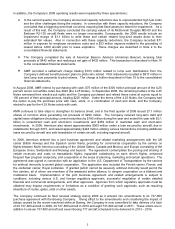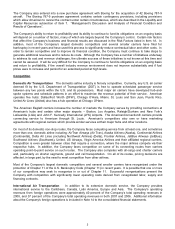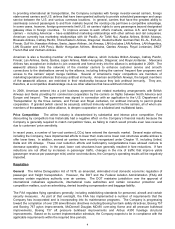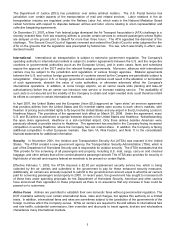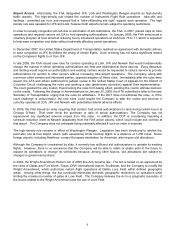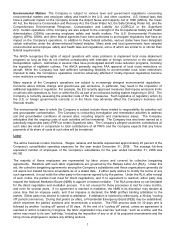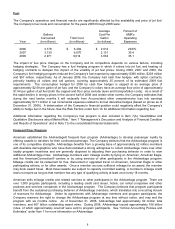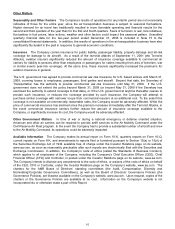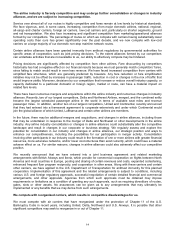American Airlines 2008 Annual Report Download - page 7
Download and view the complete annual report
Please find page 7 of the 2008 American Airlines annual report below. You can navigate through the pages in the report by either clicking on the pages listed below, or by using the keyword search tool below to find specific information within the annual report.
4
In providing international air transportation, the Company competes with foreign investor-owned carriers, foreign
state-owned carriers and U.S. airlines that have been granted authority to provide scheduled passenger and cargo
service between the U.S. and various overseas locations. In general, carriers that have the greatest ability to
seamlessly connect passengers to and from markets beyond the nonstop city pair have a competitive advantage.
In some cases, however, foreign governments limit U.S. air carriers' rights to carry passengers beyond designated
gateway cities in foreign countries. To improve access to each other's markets, various U.S. and foreign air
carriers – including American – have established marketing relationships with other airlines and rail companies.
American currently has marketing relationships with Air Pacific, Air Tahiti Nui, Alaska Airlines, British Airways,
Brussels Airlines, Cathay Pacific, China Eastern Airlines, Dragonair, Deutsche Bahn German Rail, EL AL, EVA Air,
Finnair, Gulf Air, Hawaiian Airlines, Iberia, Japan Airlines, Jet Airways, LAN (includes LAN Airlines, LAN Argentina,
LAN Ecuador and LAN Peru), Malév Hungarian Airlines, Mexicana, Qantas Airways, Royal Jordanian, SNCF
French Rail and Vietnam Airlines.
American is also a founding member of the oneworld alliance, which includes British Airways, Cathay Pacific,
Finnair, Lan Airlines, Iberia, Qantas, Japan Airlines, Malév Hungarian, Dragonair, and Royal Jordanian. Mexicana
Airlines has accepted an invitation to join oneworld and formal entry into the alliance is anticipated in 2009. The
oneworld alliance links the networks of the member carriers to enhance customer service and smooth
connections to the destinations served by the alliance, including linking the carriers' frequent flyer programs and
access to the carriers' airport lounge facilities. Several of American's major competitors are members of
marketing/operational alliances that enjoy antitrust immunity. American and British Airways, the largest members
of the oneworld alliance, are restricted in their relationship because they lack antitrust immunity. They are,
therefore, at a competitive disadvantage vis-à-vis other alliances that have antitrust immunity.
In 2008, American entered into a joint business agreement and related marketing arrangements with British
Airways and Iberia providing for commercial cooperation by the carriers on flights between North America and
Europe and beyond. The agreement was signed in connection with an application to the U.S. Department of
Transportation by the three carriers, and Finnair and Royal Jordanian, for antitrust immunity to permit global
cooperation. If granted (which cannot be assured), antitrust immunity will permit the five carriers, all of whom are
members of the oneworld airline alliance, to deepen cooperation on a bilateral and multilateral basis.
Price Competition The airline industry is characterized by substantial and intense price competition. Fare
discounting by competitors has historically had a negative effect on the Company’s financial results because the
Company is generally required to match competitors' fares, as failing to match would provide even less revenue
due to customers’ price sensitivity.
In recent years, a number of low-cost carriers (LCCs) have entered the domestic market. Several major airlines,
including the Company, have implemented efforts to lower their costs since lower cost structures enable airlines to
offer lower fares. In addition, several air carriers have recently reorganized under Chapter 11, including United,
Delta and US Airways. These cost reduction efforts and bankruptcy reorganizations have allowed carriers to
decrease operating costs. In the past, lower cost structures have generally resulted in fare reductions. If fare
reductions are not offset by increases in passenger traffic, changes in the mix of traffic that improve yields
(passenger revenue per passenger mile) and/or cost reductions, the Company’s operating results will be negatively
impacted.
Regulation
General The Airline Deregulation Act of 1978, as amended, eliminated most domestic economic regulation of
passenger and freight transportation. However, the DOT and the Federal Aviation Administration (FAA) still
exercise certain regulatory authority over air carriers. The DOT maintains jurisdiction over the approval of
international codeshare agreements, international route authorities and certain consumer protection and
competition matters, such as advertising, denied boarding compensation and baggage liability.
The FAA regulates flying operations generally, including establishing standards for personnel, aircraft and certain
security measures. As part of that oversight, the FAA has implemented a number of requirements that the
Company has incorporated and is incorporating into its maintenance programs. The Company is progressing
toward the completion of over 200 airworthiness directives including Boeing fuel tank safety directives, Boeing 757
and Boeing 767 pylon improvements, McDonnell Douglas MD-80 over-wing frame and aft pressure bulkhead
improvements, Boeing 737 aft pressure bulkhead improvements and Airbus A300 fuselage structural
improvements. Based on its current implementation schedule, the Company expects to be in compliance with the
applicable requirements within the required time periods.





